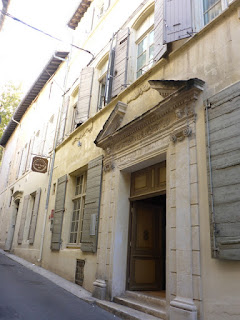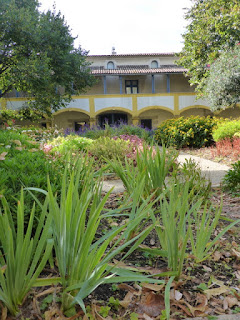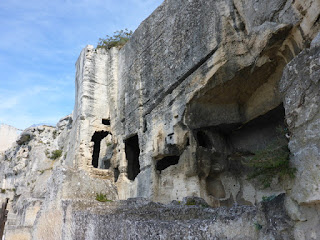Arles wqs going to be the day for walking in Van Gogh’s footsteps. When we arrived the market was in progress and that changed the flow of traffic confusing our Renault’s GPS a little. Johnny worked it out. The Vinci car parks were a godsend and they saved us again. They all played piped classical music and it really did add something to the place.
As with so many large southern French towns, there was a rich Roman history in Arles. We walked around the outside of the amphitheatre that was built in 90 AD, and had seating for over 20,000 spectators. With the fall of the Roman empire in the 5th century, the amphitheatre became a shelter for the population and was transformed into a fortress. The structure encircled more than 200 houses. More recently it became an arena for bull fighting but instead of the bloody Spanish style, they had a contest between unarmed bull fighters and the bull, where to win, men had to pluck a ribbon from the bull’s horns.
After the arena and a tour of the streets (and of course a mandatory coffee in the shade of the amphitheatre) we walked by the Rhone river. The river was broad and clean but ignored by the city. It looked as if a lot of work was in progress to protect the banks from erosion. We had a chance to see behind the crumbly historic façades of the houses. One had been made into a hotel so I slipped inside. It was so flashy and new. It was like stepping through a mirror into another time.
Though Van Gogh spent a short time in Arles, it was one of his most productive and manic periods. We tried to trace some of the sites related to his painting but they didn’t make it easy. We found the yellow café that he painted. He wanted to set up his own art community there with the artist Gauguin. Then as we trawled through the streets, quite by accident we came across the hospital to which he was taken when he sliced his ear off. The building had a wonderful enclosed garden and its look belied the misery that a building like that would have seen in the past.
We returned to the market and bought food for a picnic. We drove out of Arles to the Langlois Bridge that Van Gogh painted several times. The original bridge became unstable and was replaced but the Germans blew the new bridge up during the war. This allowed the city to rebuild the original bridge. Again, the city hardly acknowledged the significance of the bridge but as Johnny and I had a picnic on a bed of mown grass we could see a stream of visitors pulling up in their cars to have a look at the structure and take their photos. There was also a wonderfully flat bike path next to the canal that the bridge crossed so there were people unloading bikes and taking them out for a tour of the countryside.
Our original plan was to return directly to Marseille. On a whim we changed plans and instead turned back to visit Les Baux De Provence. It had a spectacular position in the Alpilles mountains. It grew out of a rocky outcrop that was crowned with a ruined castle overlooking the plains to the south. The town was named after the aluminium ore bauxite, which was first discovered there by geologist Berthier in 1821, but the castle hailed from a much earlier period. Even though it meant some very difficult climbing again we had a great time exploring this picture postcard place. The defensive setting of Les Baux led to the site being settled early on in human history. Traces of human settlements in the area dated from 6000 BC, During the Middle Ages it became the home of a powerful feudal Lord that controlled 79 towns and villages in the vicinity.
We carried a recorded explanation with us that set the scene of each area and explained the history of what we wer viewing. We saw life sized battering rams, trebuchets and catapults. There was a mason carving gargoyles, a smith making armour and a woman spinning wool. We climbed right up to the top, walking through the homes chiselled out of the stone and the rooms built from the hewn rock. When we reached the absolute pinnacle and I saw the condition of the steps and the warning that the local council would not take any responsibility for any accident or damage if you proceeded further, I decided it was time to pause and let Johnny go forth alone.
Brilliant as the castle was, for me the best thing was the view of the limestone faces of the hills and the pattern of the Provencal farms and homes on the land below.
From here we took the freeway back to Marseilles, where we had to return the car. Once we booked into the hotel and had a shower we were ready for dinner. The hotel was chosen for its proximity to the train that we had to catch the next morning to Paris. It was a new and very comfortable place but because of its proximity to the train the area was full of gypsy beggars. I saw one mother laying into her 6 and 7 years olds because they came back to her with nothing. Whole families (7-10 people) walked around with all their possessions either in shopping trolleys or hanging off kids’ pushers. It was a very dispiriting sight.
Around the hotel was not the place to find a decent meal so we walked through the city back to the waterfront with which we were familiar. We had not seen this part of the city before. The streets were as wide as the Paris boulevards and like Paris, they had planned for each incredibly long avenue to end in a wonderful historical monument. The streets thronged with crowds of people but there was still something edgy about the atmosphere so we kept a tight grip on our bags.
At the front we found a really good restaurant. There was good food, attentive and prompt service.
Tomorrow at 8.15 we leave for the TGV and travel at 300km per hour to Paris. Bon nuit. Catch you tomorrow, Lily



















































































































































































































































































































































































































































































